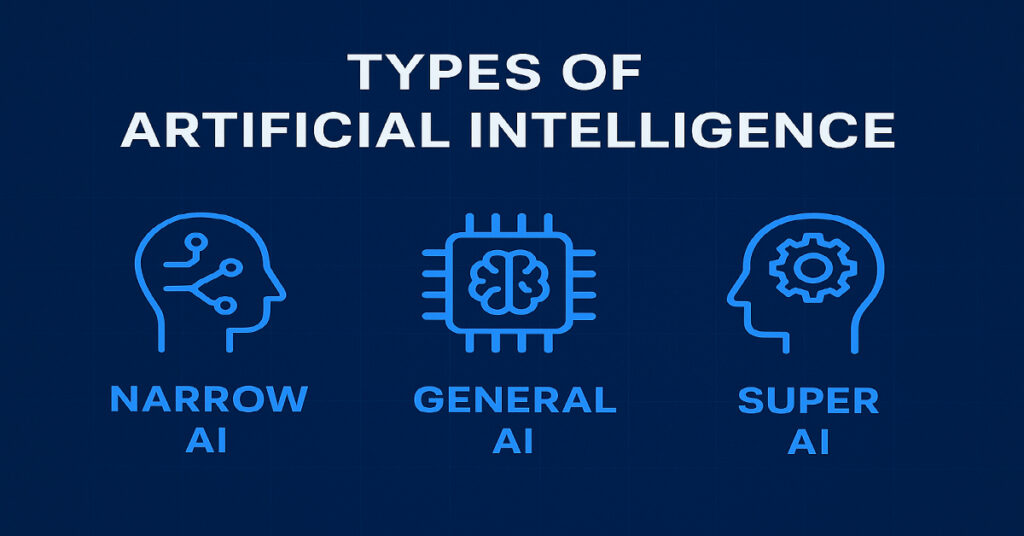Exploring the Main Types of Artificial Intelligence: From Narrow AI to Super AI * Introduction: The Rise of Artificial

Intelligence
Artificial Intelligence (AI) is no longer just a futuristic dream—it’s the backbone of the modern digital world. From smart assistants like Siri and Alexa to complex data-driven systems that power business decisions, AI is transforming every industry. But have you ever wondered how AI actually works or what types exist? Understanding the types of Artificial Intelligence helps us see how machines evolve—from simple task-based programs to systems that could one day rival human intelligence.
In this article, we’ll explore the main types of AI, their real-world examples, and how they’re shaping the future of AI technology and AI development.
* 1. Narrow AI: The Present Powerhouse
Narrow AI, also known as Weak AI, is the most common form of artificial intelligence in use today. It is designed to perform specific tasks—such as recognizing speech, identifying images, or recommending products—without possessing true understanding or consciousness.
* Real-World Examples
Voice Assistants: Siri, Alexa, and Google Assistant.
Streaming Recommendations: Netflix suggesting your next movie.
Search Engines: Google’s algorithms predicting user intent.
Narrow AI may sound limited, but it’s the foundation of most modern innovations. It enables AI in business, powering automation, customer service chatbots, and predictive analytics. Although it cannot think beyond its programming, its efficiency and precision make it invaluable.
* 2. General AI: The Human-Like Thinker
General AI, or Strong AI, refers to machines that can understand, learn, and apply knowledge across different domains—just like a human brain. Unlike Narrow AI, which is restricted to one function, General AI could perform any intellectual task a human can.
* Potential Capabilities
Learn new skills without explicit programming.
Think critically, reason logically, and adapt to change.
Make decisions based on emotional and ethical understanding.
While General AI remains mostly theoretical, many researchers and developers are working to bring it closer to reality. Advances in machine learning, deep learning, and neural networks are slowly paving the way for this intelligent evolution.
* 3. Super AI: Beyond Human Intelligence
Super AI is the most advanced and hypothetical form of artificial intelligence—where machines surpass human intelligence in every aspect. It would have superior problem-solving abilities, emotional understanding, and creativity that even humans cannot match.
* What Could Super AI Do?
Self-improvement without human help.
Predict complex global events.
Design new technologies and medicines autonomously.
Many experts believe Super AI could revolutionize the world—or pose ethical challenges if not properly controlled. The future of AI will depend heavily on how we balance innovation with responsibility.
* 4. The Role of Machine Learning in AI Development
No discussion about AI is complete without Machine Learning (ML)—the core engine behind AI’s rapid progress. ML allows systems to learn from data, improve their performance over time, and make predictions with minimal human input.
* Common Machine Learning Applications
Fraud detection in finance.
Predictive maintenance in manufacturing.
Personalized marketing in eCommerce.
By combining ML with advanced algorithms, companies can automate decision-making and improve accuracy across all industries. This technology is crucial for driving both AI development and business growth.
* 5. AI in Business: Revolutionizing the Modern Workplace
Artificial Intelligence is not just for scientists—it’s transforming businesses worldwide. From startups to multinational corporations, AI in business is driving smarter workflows, enhancing productivity, and reducing costs.

* How Businesses Use AI
Customer Support: AI chatbots and voice assistants.
Data Analytics: Predicting consumer behavior.
Automation: Streamlining supply chain and HR processes.
Marketing: Targeting the right audience with smart recommendations.
The impact of AI in business goes beyond automation; it’s redefining the way we work, analyze, and grow.
* 6. The Future of AI Technology
The future of AI is both exciting and unpredictable. As technology evolves, AI will continue to integrate deeper into our daily lives—enhancing education, healthcare, and entertainment. We can expect AI systems that understand emotions, make ethical decisions, and even collaborate with humans in creative fields.
* Emerging AI Trends
Explainable AI (XAI) for transparency.
AI-powered robotics in healthcare.
Human-AI collaboration in design and creativity.
Sustainable AI solutions for energy and climate.
However, the journey ahead also demands caution. Ethical AI development, data privacy, and regulation will play crucial roles in ensuring that AI serves humanity rather than replaces it.
* Conclusion: A Smarter Tomorrow
Artificial Intelligence is more than just a technological trend—it’s a revolution that’s shaping the future of humanity. From Narrow AI doing everyday tasks to the potential of Super AI surpassing human limits, AI continues to evolve faster than ever. Understanding these types helps us appreciate not only what AI can do today but also what it could achieve tomorrow.
❓ FAQs: What People Often Ask About AI
1. What are the main types of Artificial Intelligence?
The three main types are Narrow AI, General AI, and Super AI.
2. Is Machine Learning a type of AI?
Yes, Machine Learning is a subset of AI that helps systems learn from data without explicit programming.
3. What is the difference between Narrow AI and General AI?
Narrow AI performs specific tasks, while General AI can think and learn like a human across multiple domains.
4. Can AI replace humans in the future?
AI can automate many tasks but lacks emotional intelligence and ethical judgment, so complete replacement is unlikely.
5. How is AI used in business?
AI improves automation, customer experience, and decision-making in industries like finance, healthcare, and marketing.
6. What are examples of AI technology?
Examples include self-driving cars, voice assistants, image recognition software, and recommendation systems.
7. What does the future of AI hold?
The future will see more ethical, transparent, and human-friendly AI systems enhancing every part of our lives.